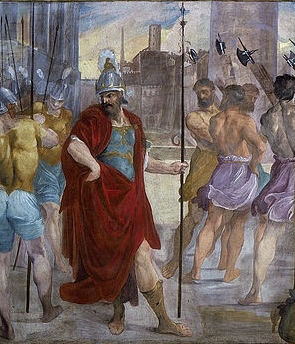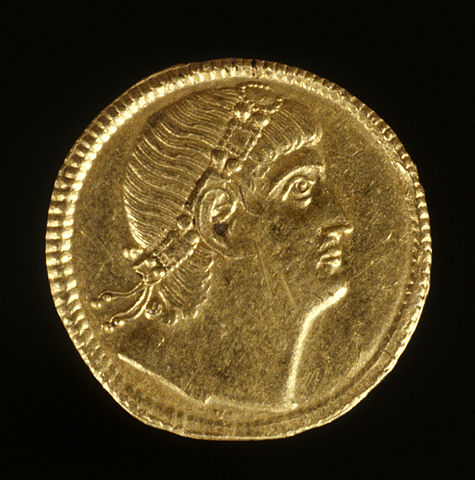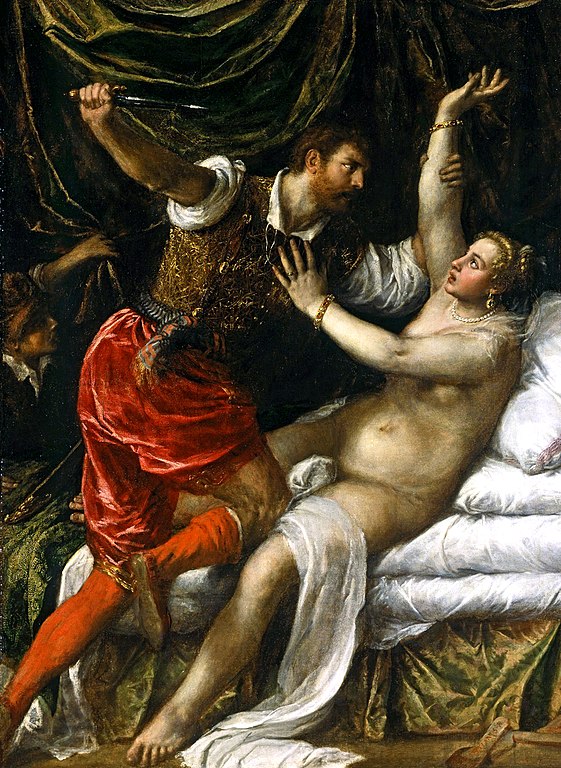
The Pride of Romulus, late 16th century mural in the Palazzo Magnani, Bologna, part of the Histories of the Foundation of Rome by the Brothers Carracci (Public domain)
According to legend, early Rome was ruled by kings (reges) from 753-509 BC. Apparently. Every country needs a foundation legend, however lost in the mists it may be.
The king was said to have possessed absolute power over the people; no one could rule over him. The senate was a weak oligarchy, capable of exercising only minor administrative powers, so that Rome’s king was effectively an absolute monarch. The senate’s main function was to carry out and administer the wishes of the king.
After Romulus, Rome’s first legendary ruler, kings were elected by the people of Rome, sitting as a curiate assembly, who voted on the candidate that had been nominated by a chosen member of the senate called an interrex. A process fraught with potential corruption. (You can almost taste the conflict between sincere men of good intention and the chancers with money and/or influence or the biggest gang of bully-boys.)
Anyway, candidates for the throne could be chosen from any source; none of this ‘citizen of Rome’ malarky that would come later in the hierarchical Republic and Empire. Lucius Tarquinius Priscus, for example, who reigned c. 616-578 BC (38 years) was originally a migrant from a neighbouring Etruscan city-state. The people of Rome, sitting as the curiate assembly, could then either accept or reject the nominated candidate-king.
Well, the Romans became fed up with the antics of the last king, Lucius Tarquinius Superbus (534 – 509 BC). Tarquin was said to have been either the son or grandson of Lucius Tarquinius Priscus, the fifth king of Rome, and to have gained the throne through the murders of both his wife and his elder brother, followed by the assassination of his predecessor, Servius Tullius.
His subsequent reign was full of abuse of power, murder, seizing other people’s property and general bad behaviour. His son Sextus Tarquinius (also, confusingly, called Tarquin) raped the virtuous wife of a consul, Lucretia (as later depicted by Titian and the subject of the opera by Benjamin Britten), and Tarquin senior conspired with Rome’s arch enemy, Lars Porsena, in an attempt to recover his throne.
Senior Tarquin’s reign has been described as a tyranny that justified the abolition of the monarchy. The establishment of the Roman Republic from approx 509 BC led to a limited separation of powers (executive, justice, legislation) and the rise of the system of magistrates, senators, consuls, praetors, tribunes, etc. and the odd temporary dictator. But as we know, it wasn’t all plain sailing…
But such was the horror that Romans instinctively felt of returning to rule by kings that even Julius Caesar, the most powerful man of his time, and Augustus, the first to count as emperor in historians’ eyes, were never crowned as such. They and Roman heroes throughout the Republic wore many versions of laurel, oak leaf, grass or metal wreaths (coronae) at times as marks of distinction, but never went through anything resembling a coronation. (Yet the word ‘coronation’ derives from the Latin ‘corona’…)
But things moved on…
The corona radiata, the ‘radiant crown’ possibly worn by the Colossus of Rhodes as a representation of Helios, was worn by Roman emperors as part of the cult of Sol Invictus, part of the imperial cult as it developed during the 3rd century. So the origin of the crown has religious meaning, comparable to the significance of a halo, marking the sacral nature of such leadership, expressing that either the leader is himself divine, or ruling by divine right.
The precursor to the crown we know was the browband or headband called a diadem, which had been worn by the Achaemenid rulers, the ancient Iranian empire founded by Cyrus the Great in 550 BC. Constantine I, who became the ‘Dominate’ Roman emperor par excellence in the early fourth century decided to adopt it as a symbol of his absolute power.

Gold medallion showing Constantine I wearing a jewelled diadem. Struck at Nicomedia in 336–337 AD to celebrate the 30th anniversary of his rule
The Dominate system of government emerged as a response to the chaos that of the crisis of the third century. The chronic usurpations, military insurrections, simultaneous military conflicts across multiple frontiers exposed the weaknesses in the Roman state as governed under the classic Principate imperial system.
After AD 285 a gradual but relentless move began from the collegiate model of government to a more autocratic version. The senatorial elite began to be excluded from high military commands and the equestrians (middle ranking aristocrats/upper middle class) became more important in government and the military.
The army was reorganised, imperial dress changed from simpler tunics and togas to (often ornate) robes and pallia, and ceremonial displays became more extravagant. Religious policy aimed at religious unity and large scale monetary reforms and the creation of an empire-wide civil bureaucracy became the norm.
Following the assumption of the diadem by Constantine, Roman and Byzantine emperors continued to wear it as the supreme symbol of their authority. Although no specific coronation ceremony was observed at first, one gradually evolved over the following century. Even Emperor Julian the Apostate/Philosopher who yearned for the values, religion and behaviour of earlier Roman times, was hoisted upon a shield and crowned with a gold necklace provided by one of his standard-bearers; he later wore a jewel-studded diadem.
Later emperors were crowned and acclaimed in a similar manner until the momentous decision was taken to permit the patriarch of Constantinople to physically place the crown on the emperor’s head.
The first imperial coronation was organised by Leo I, who was crowned by Patriarch Anatolius of Constantinople in 457 AD. This Christian coronation ritual was performed by almost all future emperors and later imitated by courts all over Europe.
And, as they say, the rest is history.
Alison Morton is the author of Roma Nova thrillers – INCEPTIO, CARINA (novella), PERFIDITAS, SUCCESSIO, AURELIA, NEXUS (novella), INSURRECTIO and RETALIO, and ROMA NOVA EXTRA, a collection of short stories. Audiobooks are available for four of the series. Double Identity, a contemporary conspiracy, starts a new series of thrillers. JULIA PRIMA, a new Roma Nova story set in the late 4th century, is now out.
Download ‘Welcome to Alison Morton’s Thriller Worlds’, a FREE eBook, as a thank you gift when you sign up to Alison’s monthly email update. You’ll also be among the first to know about news and book progress before everybody else, and take part in giveaways.














Leave a Reply